#end permian extinction
Text
Nature, 252 mya: LYSTROSAURUS SWEEEEEEEEEEEEEEP
1K notes
·
View notes
Text
Ya know, I get that mass extinctions happen in an evolutionary blink of an eye, but they didn’t happen in a literal blink of an eye. I want more documentaries that take place during these extinctions. Show me what life was like during the Great Dying, don’t just tell me. Show me the survivors of Chicxulub and how they did or didn’t survive through Impact Winter.
#paleontology#evolution#extinction#great dying#end Permian extinction#chicxulub#end Cretaceous extinction#dinosaur#documentary#rewatching#life on our planet#peregrine op
38 notes
·
View notes
Text
anyone else thinking about the siberian traps and the end permian mass extinction tonite .....
#girl the volcanoes.... girl the anaerobic bacteria at the bottom of the lake that i cant remember the name of#girl the extremely poisonous bacteria at the bottom of the lake#girl the anaerobic bacteria used as evidence to support the idea that the siberian traps were a#major factor in the end permian mass extinction.. girl.......#i have an exam next week and . i am having a fun time studying for it#we also talked about primate and hominid evolution!! not as much as i would've hoped :~(#BUT!!! STILL!!!!!
3 notes
·
View notes
Text
Does anyone else here ever just think about the great dying?
0 notes
Text
on. a somewhat related note to that post?? if there is one thing that brings me even just a little small smile when im worried about climate change and the sixth extinction and stuff, even though its a very Dark Thought that revolves around a future i REALLY HOPE WE DONT HAVE, is that even if everything is fucking fucked and climate change eats and kills everything in its way every person every animal plant fungus microbe, and we and everything we know and knew is gone, i am. fairly confident that something else will take our place. life is just gonna keep going on. because even in literal scorched earth, life will somehow keep going.
#or maybe that's just my naive guesswork and all life and evolution really will come to an end because of the sixth ectinction. LOL#but if life survived the fucking permian extinction i want to believe it can survive this#if it all goes to shit#t
1 note
·
View note
Note
Whoa. What in God's name is the Great Dying? That sounds horrifying.
the Great Dying is the colloquial name for the End-Permian mass extinction event, which separates the Permian from the Triassic in the geological record.

and it's called that for a reason, because the Great Dying killed, no joke, 90% of all animals on planet Earth in the worst mass extinction of all time! the Earth before the Great Dying was an alien land full of crocodile relatives, mammal ancestors, and more weird fish than you could shake a reasonably-sized stick at.

<art src: Julius T. Csotonyi>
the world after the Great Dying was a blasted hellscape, with few survivors either in the sea or on land.
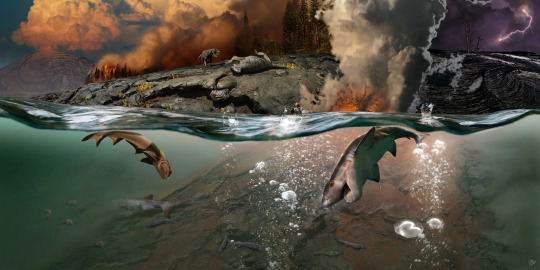
<art src: Julius T. Csotonyi>
one of those land-bound survivors was the ancestor of all mammals, and another was the first of the dinosaurs! the next geologic age, the Triassic, would see the rise of dinosaurs and pterosaurs and even seagoing ichthyosaurs to replace the multitude of lineages that fell during the Great Dying.
but what caused this chaotic event?
the death of a supercontinent, no joke.

Pangea was very much a thing at the time, but plate tectonics were starting to literally rip it apart at the seams. and when the seams split, a volcanic hellstorm was unleashed that hurled lava MILES into the air and covered the land in lava beds over a mile thick, releasing gigantic stores of carbon dioxide that dwarf the maximum amount humans could ever release by an order of magnitude! and also poisonous hydrogen sulfide gas. that will be important later.
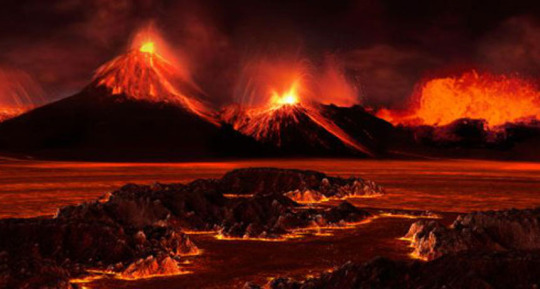
so what happened next was runaway global warming that rapidly turned the entire planet except for the poles completely uninhabitable. the ocean got so warm that it was as hot as a hot tub at the equator, which made the water unable to hold dissolved gases and sent the breathable oxygen levels in the ocean plummeting worldwide, suffocating basically everything in it. the land was covered in a haze of highly toxic gas and punishing heat that poisoned and baked animals alive, while the hot ocean waters may have fueled hurricanes the size of entire continents that ravaged both earth and sea down to the bedrock!
the whole fucking planet looked more like Venus than anything we'd recognize today.

so basically, this was the lowest point of animal life on Earth. it took many millions of years for our planet to recover, and we all should be thankful that, whatever humanity unleashes in the future, at least it won't be as bad as the Great Dying.
12K notes
·
View notes
Text
I think the end Permian extinction was really tragic, not just for the obvious reasons, but also because of the total loss of the six winged insects, an often forgotten part of that event. Imagine if they managed to hang on, in some marginal capacity, somewhere on Pangaea. Most likely they'd still be around today, as no extinction event since then has really managed to wipe out whole orders of insects like that.
530 notes
·
View notes
Text
Selected recurrent patterns or "laws" of evolution, of potential use for speculative biology. List compiled by Neocene's Pavel Volkov, who in turn credits its content to Nikolay Rejmers (original presumably in Russian). These are guidelines, and not necessarily scientifically rigorous.
Dollo's Law, or irreversibility of evolution: organisms do not evolve back into their own ancestors. When mammals returned to the sea, they did not develop gills and dermal scales and change back into fish: they became whales or seals or manatees, who retain mammalian traits and show marks of land-dwelling ancestry.
Roulliet's law, or increase of complexity: both organisms and ecosystems tend to become more complex over time, with subparts that are increasingly differentiated and integrated. This one is dodgier: there are many examples of simplification over time when it is selected for, for example in parasites. At least, over very large time scales, the maximum achievable complexity seems to increase.
Law of unlimited change: there is no point at which a species or system is complete and has finished evolving. Stasis only occurs when there is strong selective pressure in favor of it, and organism can always adapt to chaging conditions if they are not beyond the limits of survival.
Law of pre-adaptation or exaptation: new structures do not appear ex novo. When a new organ or behavior is developed, it is a modification or a re-purposing of something that already existed. Bone tissue probably evolved as reserves of energy before it was suitable to build an internal skeleton from, and feathers most likely evolved for thermal isolation and display before they were refined enough for flight.
Law of increasing variety: diversity at all levels tends to increase over time. While some forms originate from hybridization, most importantly the Eukaryotic cells, generally one ancestor species tends to leave many descendants, if it has any at all.
Law of Severtsov or of Eldredge-Gould or of punctuated equilibrium: while evolution is always slow from the human standpoint, there are moments of relatively rapid change and diversification when some especily fertile innovation appears (e.g. eyes and shells in the Cambrian), or new environments become inhabitable (e.g. continental surface in the Devonian), or disaster clears out space (e.g. at the end of the Permian or Cretaceous), followed by relative stability once all low-hanging fruit has been picked.
Law of environmental conformity: changes in the structure and functions of organisms follow the features or their environment, but the specifics of those changes depend on the structural and developmental constraints of the organisms. Squids and dolphins both have spindle-shaped bodies because physics make it necessary to move quickly through water, but water is broken by the anterior end of the skull in dolphins and by the posterior end of the mantle in squids. Superficial similarity is due to shared environment, deep structural similarity to shared ancestry.
Cope's and Marsh's laws: the most highly specialized members of a group (which often includes the physically largest) tend to go extinct first when conditions change. It is the generalist, least specialized members that usually survive and give rise to the next generations of specialists.
Deperet's law of increasing specialization: once a lineage has started to specialize for a particular niche, lifestyle, or resource, it will keep specializing in the same direction, as any deviation would be outcompeted by the rest. In contrast, their generalist ancestors can survive with a marginal presence in multiple niches.
Osborn's law, or adaptive radiation: as the previous takes place, different lines of descent from a common ancestor become increasingly different in form and specializations.
Shmalhausen's law, or increasing integration: over time, complex systems also tend to become increasingly integrated, with components (e.g. organs of an organism, or species in a symbiotic relationship) being increasingly indispensable to the whole, and increasingly tightly controlled.
183 notes
·
View notes
Text
"black cat girls" "golden retriever boys" what about us cotylorhynchus girls?

Cotylorhynchus is an extinct genus of herbivorous caseid synapsids that lived during the late Lower Permian (Kungurian) and possibly the early Middle Permian (Roadian) in what is now Texas and Oklahoma in the United States. The large number of specimens found make it the best-known caseid. Like all large herbivorous caseids, Cotylorhynchus had a short snout sloping forward and very large external nares. The head was very small compared to the size of the body. The latter was massive, barrel-shaped, and ended with a long tail. The limbs were short and robust. The hands and feet had short, broad fingers with powerful claws. The barrel-shaped body must have housed large intestines, suggesting that the animal had to feed on a large quantity of plants of low nutritional value. Caseids are generally considered to be terrestrial, though a semi-aquatic lifestyle has been proposed by some authors. The skull of Cotylorhynchus shows the typical caseid morphology with a forward sloping snout, very large nasal opening, a skull roof with numerous small depressions, and a very large pineal foramen. The latter is wider than long as in Ennatosaurus and thus differs from that of Euromycter which is subcircular.[2] The number of teeth in the upper and lower jaws ranges from 16 to 20. In the upper jaw, the anterior teeth are long and slender, while those behind decrease in size posteriorly and are slightly spatulate. All the marginal teeth have their distal end slightly inclined towards the interior of the mouth and the top of their crown each have three small cuspules arranged longitudinally. These teeth also show an enlargement of the central part of the crown.[3] In the lower jaw, the anterior teeth, not denticulate according to Olson, are shorter and tilt slightly forward. Other lower teeth are similar to those in the upper jaw. The postcranial skeleton is massive. The ribs are very long, heavy and curved to form a bulbous body. Ribs are present on all the pre-sacral vertebrae and the first caudal vertebrae. The five posterior presacral ribs are fused with the transverse processes of the vertebrae. The sacrum contains three vertebrae. The neural spines of larger specimens become proportionately taller, especially in the pelvic region. The limbs are short and strong. The femur is characterized by its proximal end having a broad shelf marked by a margin slightly overhanging the dorsal surface of the femur. The pes and manus are broad and short, and terminate in strong, sharp, and curved ungual phalanges which must have supported powerful claws. Muscle and tendon scars are very developed.[3]The genus Cotylorhynchus is represented by three species, the largest of which could reach more than 6 m in length. However, a study published in 2022 suggests that the genus may be paraphyletic, with two of the three species possibly belonging to separate genera. The genus name Cotylorhynchus comes from the Greek kotyle, cup, hollow, and rhynchos, beak, or snout. The genus was named so because of the nasal opening which is surrounded by a depressed, cup-shaped bony surface.[1] The genus Cotylorhynchus contains three species which differ in size and proportion, C. romeri (the type species), C. hancocki, and C. bransoni. In C. romeri there are two size groups which presumably represent sexual dimorphism. There is no size overlap between adults of C. romeri and C. hancocki, but larger specimens of C. bransoni have roughly the same dimensions as smaller specimens of C. romeri.[3] In 2022, Werneburg and colleagues suggested that the species C. hancocki and C. bransoni might not belong to the genus Cotylorhynchus. These authors consider that a detailed revision of these two taxa is necessary to clarify their status.[4]
187 notes
·
View notes
Text
One paleoart for each period since the Cryogenian
Thanks to the timeline on my walls that I've been trying to fill in with my art, I have now reached the point where I've done paleoart for every single period of the Phanerozoic, plus the Ediacaran and Cryogenian! That is to say, every period of the last 700 million years. So with that milestone, I thought it'd be fun to go through those periods in order and show off one paleoart of mine for each!
Cryogenian

In the Cryogenian, the Earth completely froze over. Twice! Life wasn't much to look at yet, but I enjoyed drawing what our planet might have looked like at the time. The girdle of lakes at the left is the equator, which may have had ice-free patches.
Ediacaran
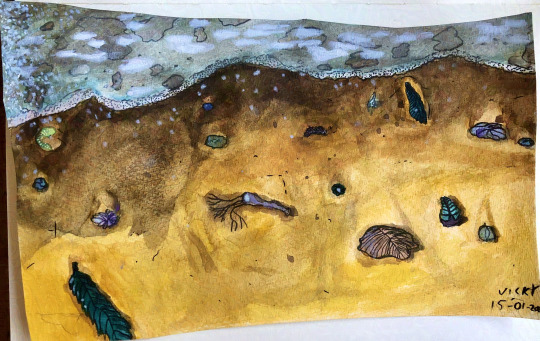
When the ice retreated, animals first began to blossom into their endless forms most beautiful. Ediacaran life was strange and quite unlike the creatures that would come later, but it was nonetheless an incredibly important chapter in life's history. Here we see the Ediacaran weirdos washing up on shore after a storm.
Cambrian

The Cambrian explosion brought much more recognisable creatures. But one thing that's easy to miss is that they were all tiny! All of them? No, Anomalocaris was, with a length of about 40 cm, the dragon of the Cambrian.
Ordovician

Life continued to diversify in the Ordovician, and among this diversity were the cephalopods. They produced the largest animals yet to exist, the orthocones, who hung vertically in the water column and decended upon their prey like a claw game.
Silurian
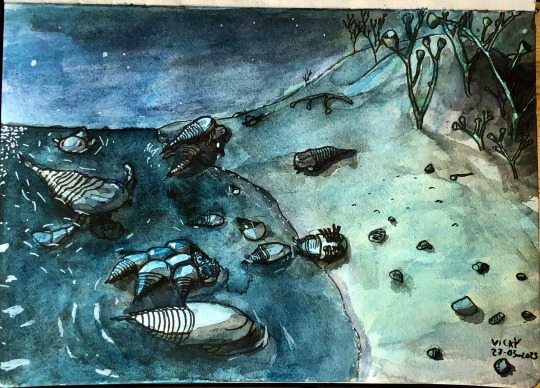
Although fungi and bacteria had already made forays onto the land deep in the past, things began to get busier there in the Silurian. But these horseshoe crabs, and their larger cousins the sea scorpions, have not come to the shore to stay, but to mate and lay eggs. Unfortunately for the horseshoe crabs, they have come to the very same shore.
Devonian
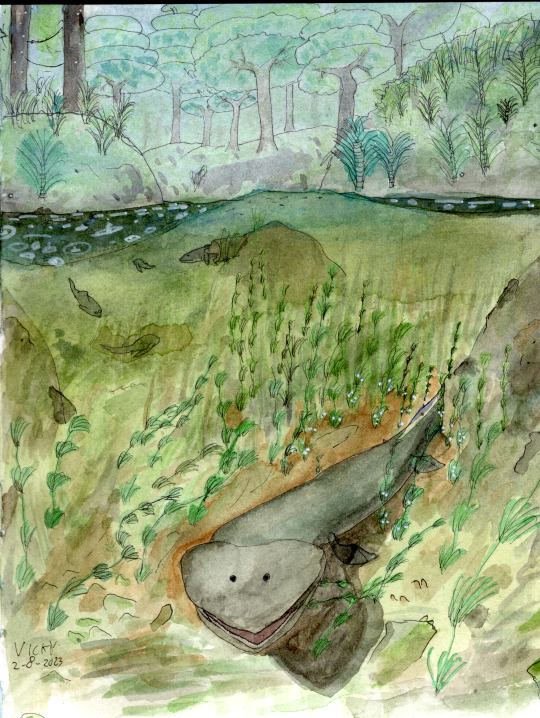
Our own vertebrate ancestors, like Tiktaalik, were pretty late to the party, only taking their first steps on land in the late Devonian. That's no knock against them - there was plenty to do underwater! This Tiktaalik is busy guarding his eggs while his mate is busy hunting, for example. Who has time to step on land?
Carboniferous

The end of the Carboniferous saw some quite large bugs, like these two Mazothairos chasing off an interloping Meganeura. They're representatives of a pretty interesting group of basal insects called the Palaeodictyoptera, who have a set of weird little extra wings on their thorax.
Permian
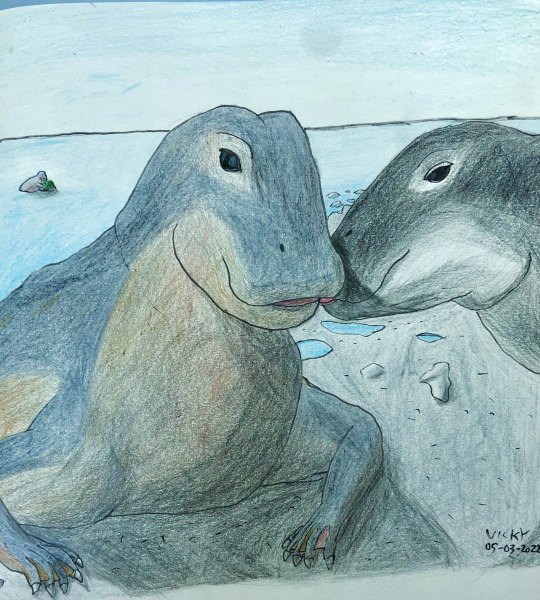
Among the many fantastic creatures of the Permian were our own cousins, the synapsids, like these lovey-dovey Moschops. As you can see, this picture and the previous one are done in coloured pencils instead of watercolour, because they're the oldest images I'm including in this post. I only very rarely used watercolours before this year. I think it means I should do some more Permian art, it's such a cool and underexposed period.
Triassic
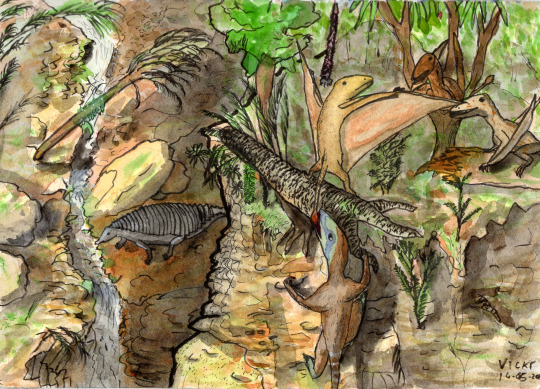
One mass extinction later, the archosaurs are diversifying all over Triassic Pangaea. Here we have the three main groups of them: Paratypothorax, a pseudosuchian in the background; Peteinosaurus, a pterosaur on top of the cliff; and Procompsognathus, a dinosaur climbing the cliff.
Jurassic

I had three different option for Jurassic paleoart to showcase, so I picked the most experimental one. These backlit insects are not butterflies, but kalligrammatids, a group of large-winged neuroptera, some of which even mimicked maniraptoran dinosaurs like this iridescent Caihong with their patterns.
Cretaceous
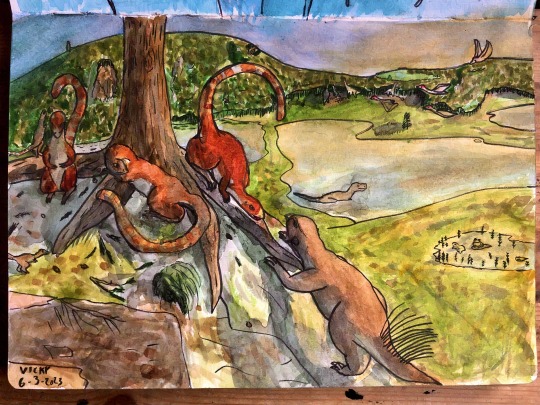
The Cretaceous featured some of life's most gorgeous crescendos of diversity, like the Yixian formation, where a Psitaccosaurus wants to visit the favourite tree of a group of Sinosauropteryxes, who are having none of it. This is still one of my favourite pieces I've ever drawn.
Paleogene
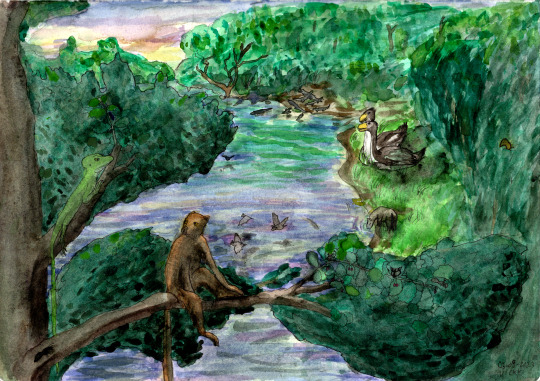
The Paleogene featured some of the highest global temperatures of all time, leading to tropical climates all over the planet, including at this lake in what will one day be Messel, Germany. Darwinius, a close cousin to our own ancestors, is having a staredown with the lizard Geiseltaliellus.
Neogene

The world turned colder and dryer in the Neogene, leading to the spread of large grasslands, like these South American ones. Phorusracos, a large terror bird, has caught a Thoatherium on the edge of the forest they both live in. South America was an isolated continent for the duration of the Neogene, leading to a quite unique fauna.
Quaternary

The Quaternary, our current period, is marked by the cycle of ice ages regularly freezing the northern hemisphere. But even during the ice ages, spring would come to the mammoth steppes, and these steppe mammoths are happy to celebrate its coming with a bath in the river.
#paleoart#my art#palaeoblr#timeline#no i am not gonna tag everything in it#the pictures should all work as links to the individual posts of these pieces#cw: animal death#cw: bugs#cw: parasites#cw: blood
304 notes
·
View notes
Note
I’m currently recovering for a bought of heatstroke and need something to keep me awake and cognizant (the hazards of fieldwork during the summer). Do you have any interesting facts about early Triassic weirdos? Admittedly that’s my least known era of prehistory, though not from a lack of trying on my part.
Lystrosaurus may not be technically just Triassic, but it gets lumped with the Triassic weirdos because the weirdest thing about it happened in the Triassic - it was most tetrapods for a decent chunk of time. They were everywhere. They did amazingly. And they went extinct the second other stuff started showing up again. It's wild.
The Early Triassic was also just the time when marine reptiles exploded. That's when we get a lot of the weirdest marine reps. Hupehsuchians? The first Nothosaurs? Pachypleurosaurs? Heck, this is even when we see the first Pistosaurs
The problem with the Early Triassic is that it's not proportional. It only lasts for a little less than five million years. That's just way too short of a time for a geological slice to show major changes, especially when it's that old.
But! There are more! Erythrosuchus first shows up in the Early Triassic, and the first Dinosauromorphs definitely appeared as showed by footprints. And, of course, there were tons of Ichthyosaurs, exacerbated by the fact that they may have originally evolved in the Permian after all
I'm hoping the more we study the Earliest Triassic, the more weirdos we will find. But yeah, you gotta go to the Middle to see the weirdness *really* take off
31 notes
·
View notes
Note
Nate have you seen "Started Out as a Fish. How Did It End Up Like This" on the new york times website? peak scicomm right there!
Thank you for alerting me to the existence of this article, I am delighted by so many of the turns of phrase in here:

"It's great, just vibes"
I am also, of course, extremely jealous of the cleverness of that title, if somewhat delighted that it reminds me of the term paper I wrote for my vertebrate paleo course last semester: It’s the End of the World as We Know It (And I Feel Fine): Resilience and Evolutionary Adaptation in Survivors of the Permian-Triassic Extinction
#actually come to think of it i also wrote a piece called 'more things than are dreamt of in your phylogeny' for a queer science website#so i have a few things that are. similar#anyways this is all delightful thank you for telling me about it!!#paleoblogging
1K notes
·
View notes
Text
Titan History: Godzilla
Welcome once again to Monarch: After Dark, the digital gateway between you and the organisation dedicated to understanding and navigating this troubled new world we live in.
For today's communication, it was decided by Monarch officials stationed at Castle Bravo (Outpost 54) that we should create an updated historical account on arguably the most recognisable and infamous of the Titans we currently know of; Godzilla.

(Pictured above: aerial footage of Godzilla leaving San Francisco the morning after G-Day, circa. 2014)
Monarch Database File: Godzilla
Monarch Designation: Titanus Gojira
Height: 393 feet
Weight: 99,634 tons
Length: 582 feet (tail)
Nature: Bio-Atomic
Behavioural Classification: Protector
---------------
A member of an ancient reptilian species that was known to exist as early as the Permian period, Godzilla serves as a guardian of the natural order, rising from the depths whenever the balance of the world is threatened, be it by other Titans or by humanity. Newfound information has revealed that, at some point in their early history, the Titanus Gojira species waged war against a population of great apes within the Hollow Earth. The outcome was victory for the former, while the latter migrated to a surface landmass that would become Skull Island, where they would face near-extinction.
Throught the millenia, imagery of these Titans showed their defense of humanity against other Titans, including the seemingly extraterrestrial lifeform, "Monster Zero". These battles were documented well, immortialised in the form of cave paintings and tales passed down through the generations.

(Pictured above: Cave painting documenting a battle between Godzilla and Monster Zero, circa. 1973)
While much of the history surrounding the individual we know today as Godzilla is unknown, his modern history is far clearer. First discovered in 1954 by founding Monarch figures William Randa, Keiko Muira and Leland Shaw, the initial reaction to the Titan's existence was an attempt to kill it using a nuclear weapon. Covered up as the Castle Bravo nuclear test, it was believed that Godzilla had been killed until he resurfaced a year later in Hateruma Island.
His next widely documented appearance was the infamous G-Day in 2014. Tracking down a mating pair of Titanus Jinshin-Mushi (aka MUTOs), Godzilla battled and eventually killed them in San Francisco, though not without extensive damage done to the city and the Golden Gate Bridge beforehand. Months later, he battled with a Jinshin-Mushi Prime, which resulted in the Prime destroying his dorsal plates before she, too, was killed.
According to Keiko Muira, and her grandchildren Cate and Kentaro Randa, who were recovered on Skull Island in 2017 through an "in-between" realm linking the surface to the Hollow Earth, Godzilla responded to a Gamma Radiation Simulator abandoned in the 1960's and battled a large dragon-like creature before they were able to escape. Their account is currently under Monarch investigation.

(Pictured above: Godzilla using an "intimidation display" in front of Monarch's Castle Bravo crew, circa. 2019)
In 2019, a mass Titan outbreak instigated by eco-terrorist Alan Jonah and Monarch paleobiologist Emma Russell called Godzilla to action once again. He first appeared in front of Castle Bravo, where he prepared to attack before the outpost lowered its weapons and calmed him down. He made way to Antarctica, where Monster Zero had recently been awakened. The two battled before the latter Titan retreated.
They clashed again off the coast of Isla de Mara, Mexico, where Godzilla succeeded in tearing off one of Monster Zero's heads. Before this battle could end, likely in Godzilla's favour, the military deployed an experimental superweapon called the Oxygen Destroyer, which severely weakened Godzilla and allowed Monster Zero to escape and regenerate its missing head before usurping control over Earth's Titans.
Their final battle took place in Boston following an evacuation of the city. Godzilla had support from an ally Titan known as Mothra to battle Monster Zero and its own ally, Rodan. The battle ravaged much of Boston, and culminated in Godzilla being dropped from the troposphere and Mothra being killed by a powerful blast from Monster Zero. With some assistance from Monarch and a final gift from Mothra, Godzilla achieved a heightened state of power and caused a thermonuclear explosion that destroyed Boston, and Monster Zero.
Following the battle, other Titans gathered around and bowed before Godzilla, accepting him as their new alpha. In the interim between this and the next major incident, Godzilla would travel the globe and keep other Titans, such as Scylla and Amhuluk, in check.

(Pictured above: Godzilla surrounded by other Titans, bowing down and accepting his claim as the alpha Titan, circa. 2019)
Following a period of minimal Titan activity, Godzilla suddenly surfaced in Pensacola, Florida and destroyed an Apex Cybernetics facility before returning to the depths. In response to this, a joint operation between Monarch and Apex went underway to use another Titan, Kong, to track down an energy source that would give humanity the edge over Godzilla before he could hurt more people.
Godzilla and Kong clashed twice. Their first battle took place in he Tasman Sea, where Godzilla intercepted a naval fleet transporting Kong to Antarctica. This encounter was short-lived, and only a last-ditch effort by ex-Monarch agent Nathan Lind prevented Kong from being killed. Their second brawl in Hong Kong placed Kong on better footing, armed with an axe he obtained within the Hollow Earth, though Godzilla still prevailed and nearly killed Kong.
However, deception from Apex allowed them to siphon the energy from the Hollow Earth into a secret anti-Titan weapon, Mechagodzilla. After losing control of the mecha, it went on a rampage and battled a weary Godzilla nearly to death before a resuscitated Kong intervened. Working together, the two Titans triumphed over Mechagodzilla and parted ways without further conflict.
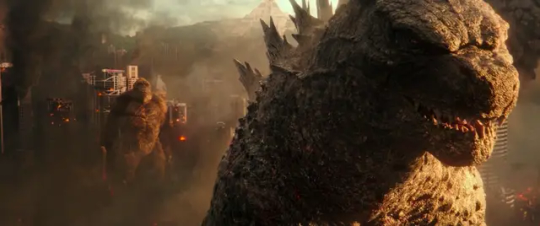
(Pictured above: Godzilla departing Hong Kong following Mechagodzilla's defeat. To date, this is the last confirmed sighting of Godzilla, circa. 2024)
---------------
And there you go! A simplified but up-to-date account of Godzilla's modern history. We will upload more information regarding him as we are authorized to do so by Monarch officials. We hope you have learned something from this historical account, and we will be back shortly with new information.
Until next time,
Monarch: After Dark
#monarch#monarch after dark#godzilla#titanus gojira#kong#monster zero#monsterverse#godzilla 2014#godzilla king of the monsters#godzilla vs kong#godzilla x kong the new empire
28 notes
·
View notes
Note
I came up with more last night sorry
"Something is Wrong, Everything is Wrong" Statement of Madoka Kaname, regarding the girl who showed her around her new school. (Puella Magi Madoka Magica: Rebellion; Spiral)
“Tourist Trap” Statement of anonymous, regarding the July 4th 2007 incident at the Permian Basin Super-organism Natural Preserve, also known as the “Mystery Flesh Pit National Park.” (Mystery Flesh Pit National Park; Flesh, Vast)
"Apple of Eden" Statement of Goro Akechi, regarding being trapped in a false reality. (Persona 5 Royal; Web, Stranger, Spiral)
"Third Book on the Left" Statement of anonymous, regarding the fire that burned down the old Winchester house. (111 Winchester; Spiral, Desolation)
"City Maintenance" Statement of Bridger Morse, regarding a set of underground tunnels connected the city sewage systems not recorded on any map. (Mayfair Watcher's Society - Underground; Flesh)
"Burn the Witch" Statement of Norman Babock, regarding the restless soul of a child who cursed his town and the task of putting her to rest. (Paranorman; End, Desolation)
“War Without Reason” Statement of an entity only identifying itself as “The Ferryman”, regarding humanity’s end and the resulting fallout in the kingdoms of heaven and hell. (ULTRAKILL; Slaughter, Extinction, Flesh)
.
26 notes
·
View notes
Photo

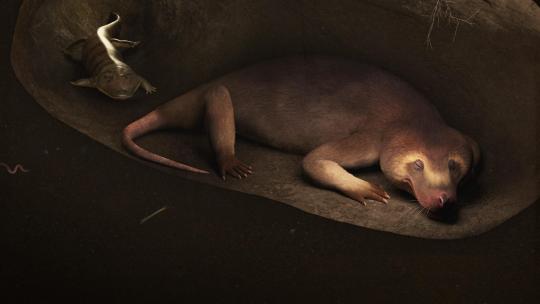
May’s Fossil of the Month - Thrinaxodon (Thrinaxodon liorhinus)
Family: Thrinaxodon Family (Thrinaxodontidae)
Time Period: Early Triassic (251-247 Million Years Ago)
At the end of the Permian period around 251 million years ago, the earth experienced the most extreme extinction event in its history (known as the Permian-Triassic Extinction Event or “The Great Dying”,) in which some 70% of terrestrial species and 81% of marine species were driven to extinction. As such, the period immediately following the Permian, the early Triassic, was a period of slow recovery as the descendants of the few survivors of the Great Dying began to adapt and diversify to fill the ecological niches left empty by the extinction of their previous occupants. Thrinaxodon liorhinus was one such survivor; a small (roughly 50cm/1.6 feet in length) species of cynodont synapsid (making it a close relative of mammals, but not a mammal itself), it inhabited what is now southern Africa and northern Antarctica (which were fused as part of a single landmass at the time) in the period immediately following the great dying, and was seemingly among the largest and most common carnivores of its time. Thrinaxodon’s survival was likely enabled at least in part due to its lifestyle; the discovery of individuals fossilized in the remains of burrows show that Thrinaxodon, like many similarly-sized mammals today, was a burrower, and the presence of distinct divisions on its spine to aid in flexibility suggests that, like many burrowing mammals and reptiles today, it may have possessed the ability to travel deeper underground and undergo hibernation or aestivation in order to endure prolonged periods of harsh weather conditions and resource scarcity. In life Thrinaxodon would have likely appeared somewhere between a large lizard and a small dog, with its leg bones and joints suggesting that it stood in a “semi-sprawling” posture mid-way between the belly-to-the-ground sprawling of most lizards and the elevated posture of most mammals, while its dog-like skull and sharp-tipped teeth (including prominent canines on both the upper and lower jaw) suggest that it was likely carnivorous, feeding on insects and/or smaller vertebrates. The discovery of the remains of several Thrinaxodon individuals, sometimes including juveniles, preserved in close proximity to one another suggests that members of this species likely provided parental care and may have also been social, and one unusual but extremely famous fossil burrow containing both an adult Thrinaxodon and an injured Broomistega putterilli (a small species of superficially salamander-like amphibian) showing puncture wounds from teeth too large to belong to the burrow’s owner suggests that, like the Gopher Tortoise and Giant Armadillo today, Thrinaxodon may have been a habitat engineer, with its burrows providing shelter for other species of animal (although it is also possible that the Broomistega had been washed into the burrow during a flood that killed both animals, or that the Thrinaxodon had stolen the injured Broomistega from the larger carnivore that wounded it.)
--------------------------------------------------------------------------
Image Sources: https://commons.wikimedia.org/wiki/File:Thrinaxodon_liorhinus_BP_1_7199.jpg
and
https://www.pbs.org/video/the-oddest-couple-in-the-fossil-record-rcehau/
#thrinaxodon#thrinaxodon liorhinus#synapsid#Synapsids#non-mammalian synapsids#cynodont#cynodonts#zoology#biology#paleontology#paleobiology#animal#animals#wildlife#prehistoric wildlife#prehistoric animals#fossil vertebrates
114 notes
·
View notes
Text

The great dying: Permo-Triassic extinction | A grande morte: Extinção Permo-Triássica
🇬🇧
The Permian-Triassic Extinction is the most devastating mass extinction event in Earth's history, occurring approximately 252 million years ago, at the end of the Permian period and the beginning of the Triassic period. This mass extinction resulted in the loss of up to 96% of marine species and 70% of terrestrial species.
The exact causes of the Permian-Triassic Extinction are still debated among scientists, but several theories have been proposed. One of them is intense volcanic activity, such as the massive eruption of the Siberian Traps, a large volcanic province in Russia. This activity released huge amounts of greenhouse gases into the atmosphere, causing drastic climate change and ocean acidification.
These catastrophic events caused widespread mass extinctions, affecting both marine and terrestrial organisms. The recovery of biodiversity after the Permian-Triassic Extinction took millions of years and profoundly influenced the subsequent evolution of life on Earth.
The relationship between the Permian-Triassic Extinction and current climate events can be observed through similarities in causative factors and consequences for life on Earth. Similarly, contemporary climate events are largely influenced by human activities, particularly the burning of fossil fuels, which releases greenhouse gases into the atmosphere. This anthropogenic activity has led to global warming, changes in precipitation patterns, rising sea levels, and ocean acidification, among other impacts. These changes are putting immense pressure on ecosystems and biodiversity, leading to species extinctions and ecosystem degradation. Both the Permian-Triassic Extinction and current climate events highlight the profound impact that changes in climate can have on life on Earth. Understanding the parallels between these events can help inform efforts to mitigate the current climate crisis and protect the planet's biodiversity and ecosystems.
🇧🇷
A Extinção Permiano-Triássica é o evento de extinção em massa mais devastador da história da Terra, ocorrido há cerca de 252 milhões de anos, no final do período Permiano e início do período Triássico. Esta extinção em massa resultou na perda de até 96% das espécies marinhas e 70% das espécies terrestres.
As causas exatas da Extinção Permiano-Triássica ainda são objeto de debate entre os cientistas, mas várias teorias foram propostas. Uma delas é a atividade vulcânica intensa, como a erupção em massa dos Trapps Siberianos, uma grande província magmática na Rússia. Essa atividade liberou enormes quantidades de gases de efeito estufa na atmosfera, causando mudanças climáticas drásticas e acidificação dos oceanos.
Esses eventos catastróficos causaram extinções em massa generalizadas, afetando tanto organismos marinhos quanto terrestres. A recuperação da biodiversidade após a Extinção Permiano-Triássica levou milhões de anos e influenciou profundamente a evolução subsequente da vida na Terra.
A relação entre a Extinção Permiano-Triássica e os eventos climáticos atuais pode ser observada através de semelhanças nos fatores causadores e nas consequências para a vida na Terra. Da mesma forma, os eventos climáticos contemporâneos são amplamente influenciados por atividades humanas, particularmente a queima de combustíveis fósseis, que libera gases de efeito estufa na atmosfera. Essa atividade antropogênica tem causado o aquecimento global, mudanças nos padrões de precipitação, aumento do nível do mar e acidificação dos oceanos, entre outros impactos. Essas mudanças estão exercendo uma pressão imensa sobre os ecossistemas e a biodiversidade, levando a extinções de espécies e degradação dos ecossistemas. Tanto a Extinção Permiano-Triássica quanto os eventos climáticos atuais destacam o profundo impacto que as mudanças climáticas podem ter na vida na Terra. Compreender os paralelos entre esses eventos pode ajudar a informar esforços para mitigar a atual crise climática e proteger a biodiversidade e os ecossistemas do planeta.
#science#paleontology#geology#universe#earth#paleobotany#biology#digital painting#space#artwork#climate#climate crisis#climate change#paleontologia brasileira#paleozóico#paleobotânica#paleomedia#paleoblr#paleoarte#paleozoic#paleontologia#paleoart#paleostream#permian#mass extinction#extinction
15 notes
·
View notes